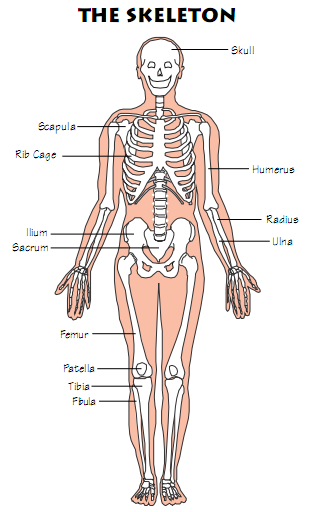Amazing Bone Facts
Amazing Bone Facts
What would happen if humans didn't have bones? You'd be floppy like a beanbag. Could you stand up? Forget it. Could you walk? No way. Without bones you'd be just a puddle of skin and guts on the floor.
Bones have two purposes. Some, like your backbone, provide the structure which enables you to stand erect instead of lying like a puddle on the floor. Other bones protect the delicate, and sometimes soft, insides of your body. Your skull, a series of fused bones, acts like a hard protective helmet for your brain. The bones, or vertebrae, of your spinal column surround your spinal cord, a complex bundle of nerves. Imagine what could happen to your heart and lungs without the protective armor of your rib cage!
How many bones do humans have?
When you were born you had over 300 bones. As you grew, some of these bones began to fuse together. The result? An adult has only 206 bones!
How do my bones move?
With a lot of help. You need muscles to pull on bones so that you can move. Along with muscles and joints, bones are responsible for you being able to move. Your muscles are attached to bones. When muscles contract, the bones to which they are attached act as levers and cause various body parts to move.
You also need joints which provide flexible connections between these bones. Your body has different kinds of joints. Some, such as those in your knees, work like door hinges, enabling you to move back and forth. Those in your neck enable bones to pivot so you can turn your head. Still other joints like the shoulder enable you to move your arms 360 degrees like a shower head.
Are your bones alive?
Absolutely. Bones are made of a mix of hard stuff that gives them strength and tons of living cells which help them grow and repair themselves. Like other cells in your body, the bone cells rely on blood to keep them alive. Blood brings them food and oxygen and takes away waste.
If bones weren't made of living cells, things like broken toes or arms would never mend. But don't worry, they do. That's because your bone cells are busy growing and multiplying to repair the break! How? When you break your toe, blood clots form to close up the space between the broken segments. Then your body mobilizes bone cells to deposit more of the hard stuff to bridge the break.
What's bone marrow?
Many bones are hollow. Their hollowness makes bones strong and light. It' s in the center of many bones that bone marrow makes new red and white blood cells. Red blood cells ensure that oxygen is distributed to all parts of your body and white blood cells ensure you are able to fight germs and disease. Who would have thought that bones make blood!
Do all critters have a backbone?
Nope. In fact, some 97% of critters on earth don' t have a backbone or spine.Remarkably enough, of those that do have a backbone, there are lots of similarities: a skull surrounding a brain, a rib cage surrounding a heart, and a jawbone or mouth opening.
Factoids
1. The human hand has 27 bones; your face has 14!
2. The longest bone in your body? Your thigh bone, the femur- it' s about 1/4 of your height. The smallest is the stirrup bone in the ear which can measure 1/10 of an inch.
3. Did you know that humans and giraffes have the same number of bones in their necks? Giraffe neck vertebrae are just much, much longer!
4. You have over 230 moveable and semi-moveable joints in your body.
5. When you lift a glass of milk and take a sip, more than 30 joints move in your fingers, wrist, arm and shoulder.
6. Joints are where bones meet.
7. Throughout life, our bones are being remolded; old bone is broken down (resorption) and new born is formed (formation).
8. During childhood and teenage years, new bone is developed faster then old bone is removed, as a result, bones grow longer and denser.
9. Maximum bone density and strength is reached around age 30.
10. Maximum bone density and strength may never be reached if there is an inadequate amount of calcium in the body.
11. Calcium is not only needed for bone growth, calcium is also needed for other things such as nerve impulses, blood clotting, and muscle contraction.
12. Osteoporosis is a disease of the bones. If maximum bone density is not reached during the bone-building years, osteoporosis is more likely to develop later in life.
13. Osteoporosis can cause bones to become fragile, weak, and prone to fracture.
14. Environmental factors of osteoporosis are: Getting enough calcium, exercising, not smoking, and avoiding excessive alcohol consumption. These factors can be controlled and can help lessen the risk osteoporosis.
15. Genetic factors such as being female, small-boned, and having a family history of osteoporosis, cannot be controlled.
16. The most effective way to build bone mass is weight bearing exercises. Weight bearing exercises are exercises that cause muscles to work against gravity. Examples are: walking, running, dancing, racquet sports, basketball, and soccer.



I bet you can't guess what muscle in your body is the #1 muscle that eliminates joint and back pains, anxiety and excessive fat.
ReplyDeleteThis "hidden survival muscle" is in your body and it will boost your energy, immune system, sexual function, strength and athletic skill when developed.